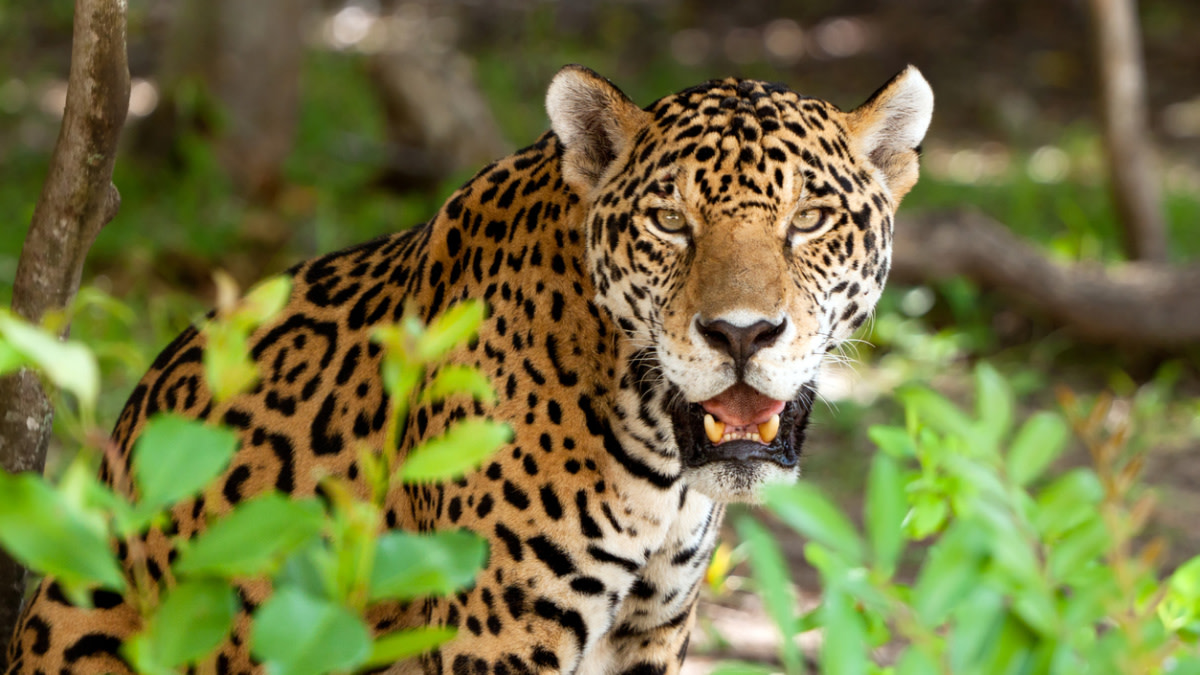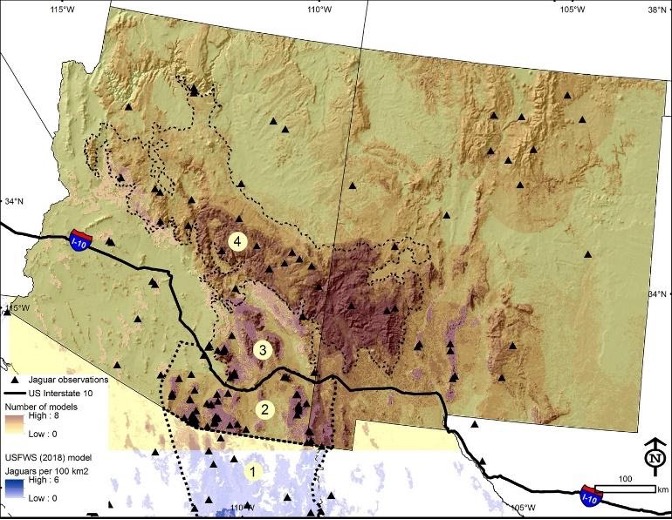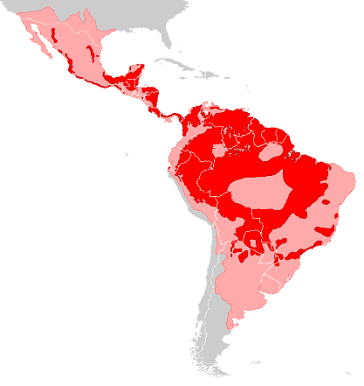
Large predator conservation is going well in the Lower 48. Wolf packs are thriving in Yellowstone and grizzly bear numbers have expanded considerably since they were listed as endangered in 1975. For some folks this is great news; for others, not so much. But one group of scientists believes there’s another large predator that needs rehabilitation: jaguars.
Led by Eric Sanderson of the Wildlife Conservation Society, a group of 16 scientists released a paper in May calling for jaguars to be reintroduced in a 31,800-square-mile tract of land in central Arizona and southwestern New Mexico. The article, published in Conservation Science and Practice, made headlines around the world as public fascination gathered around yet another of North America’s sharp-toothed mammals.
Coverage of the proposal was largely positive, but the idea wasn’t a slam dunk. Ranchers in New Mexico were none too thrilled, and hunters are concerned about jaguars reducing the number of game animals.
This topic is too large to cover sufficiently in one article, but we’ll do our best to give you the outlines. First, let’s look at what the proposal says.
The Proposal Sanderson and his team want jaguars in Arizona and New Mexico because they believe this area constitutes a small portion of the species’ native range. Sanderson believes jaguar reintroduction is a “justice issue,” and the move would help solidify the species’ presence globally.
“If a country extirpates a species, that country is on the hook to bring that species back,” Sanderson said in an interview with MeatEater. “It’s not right or moral for a country to extirpate its wildlife.”
The U.S. currently doesn’t have a breeding population of jaguars. However, they are occasionally seen in southern states, and scientists believe the closest stable population resides in northern Mexico. Sanderson and his team argue that this group is unlikely to populate New Mexico and Arizona naturally due to the loss of habitat to development, border wall infrastructure, and Interstate 10.
“It would be awesome if they could get there on their own,” Sanderson said. “It was with great regret and reluctance that the group of authors turned our minds to reintroduction. [Natural dispersal] is just very unlikely.”
Sanderson and his team chose an area in New Mexico and Arizona that they believe constitutes ideal jaguar habitat. The paper argues that the area contains sufficient water and shelter, along with the kinds of animals jaguars prefer to eat (coues deer being first on the menu).
Reintroduction efforts would likely begin by working with either captive-bred jaguars or translocating individuals from existing wild populations. The paper cites one reintroduction effort currently underway in Argentina that constructed a captive-breeding center to train young jaguars to hunt prey in the relocation area.
John Polisar, another of the paper’s co-authors, called this a “soft release,” and reported to MeatEater that six jaguars have been released in Argentina since January. These jaguars, two mothers with two cubs each, are all still alive, eating well, and not dispersing outside the reserve.
Ultimately, Sanderson says, that area could be home to 60 to 100 jaguars.
You can read the full paper here.
 The proposed recovery zone (4), the secondary recovery area (3), and the current jaguar recovery unit defined by the NSFWS (2).
The proposed recovery zone (4), the secondary recovery area (3), and the current jaguar recovery unit defined by the NSFWS (2).
Conflict 1: Why Jaguars? When we asked Sanderson and Polisar why they believe jaguars deserve to be reintroduced, they both cited the species’ historic presence in the area.
“Jaguars are part of the native fauna. Not exotics. Why do we even have a question like this?” Polisar asked. “They are as much a part of the endangered species as mussels, fish, salamanders, lizards.”
Sanderson also pointed out that the area is ecologically unique in the jaguar’s native range. “Species population isn’t about just preserving one population somewhere,” he said. “If you follow that logic to its end, it suggests that we should conserve or restore the jaguar population in all the ecological settings where they occur. And this particular ecological setting is unique in all jaguar range.”
Unfortunately, conservation is often a zero-sum game. The money that could go to relocating and managing jaguars in New Mexico and Arizona would necessarily not be used to conserve other species that are endangered or threatened in the U.S.
“The basic question for everyone is, with so many species currently listed under the [Endangered Species Act] needing our help, and 173,000 jaguars living from Sonora [Mexico] to Argentina, how important is it that we pour millions of dollars into recovering the Jaguar in AZ and NM?” asked Jim Heffelfinger, wildlife science coordinator for the Arizona Game and Fish Department. “I know they are cool, they really are, but we have obligations to so many species.”
When pressed with this particular question, Polisar admitted that complete funding will be difficult to muster, especially from the federal government. But he pointed out that other countries in Central and South America have managed to fund jaguar conservation efforts despite far less prosperous economies.
“I can’t say I know exactly where the funding will come from, but there are a number of people who find this topic inspirational,” he said. “Over 240 media outlets picked up this paper. People find these stories intriguing, this spark of wild that you could put back in.”
 The historic (light red) and current (dark red) range of jaguars. (USFWS)
The historic (light red) and current (dark red) range of jaguars. (USFWS)
Conflict 2: Native Range? The primary justification for jaguar reintroduction rests on the idea that the cats used to live in the proposed recovery area but were extirpated by humans. This sounds easy enough to determine, and the map on the website of the U.S. Fish and Wildlife Department shows jaguars extending into New Mexico, Arizona, California, Texas, and Louisiana.
Digging into the weeds, this question starts to look a lot more complicated.
Sanderson and his team report 16 independent jaguar observations between 1890 and 1964 within the recovery area, and 16 observations in areas north, south, and east of the area in Arizona and New Mexico. A female cat with cubs was trapped in 1910 (no extant physical evidence), and another female was shot in 1963 (photographs exist).
The persistence of these observations, Sanderson told us, indicates that jaguars occupied the territory continually and had established a breeding population in the area.
However, most of the evidence for jaguars within the recovery zone comes from personal testimony and has no existing physical evidence (photographs or skin/skull). One of the 16 jaguar instances, for example, is described as a “general observation” made in 1905 and recorded in an 1931 text called “Mammals of New Mexico.”
“As someone who has fielded ‘jaguar’ calls periodically for 30 years, I would say including those without physical evidence is problematic,” Heffelfinger pointed out.
The evidence of female jaguars with cubs suggests that the cats were breeding within the recovery zone. The question, of course, is whether this evidence proves the species was “native” to the area. If, for example, jaguars established a presence between 1800 and 1900, does that make them native?
Heffelfinger says no. “This wasn’t their historic range. They came up here and dispersed, and there was some reproduction before humans got here, but to me, they’re not a native species.” He also noted that unlike the Native American Tribes south of the border, jaguars don’t figure into the motifs and stories of the tribes in the Southwest. “Sometimes there’s a mention of a tiger, but it’s not part of the Southwest,” he said.
Sanderson points out in the paper that jaguars are “notoriously cryptic,” and the recovery zone was sparsely populated by humans until the second half of the 20th century. These factors suggest that even one jaguar sighting indicates the presence of a more significant population.
This still might not be enough to convince those opposed to jaguar reintroduction. Sanderson’s paper only includes evidence of jaguars within the recovery zone back to 1890, so if a species must exist for a more extended period to be considered “native,” the jaguar might not make the cut.
Check out Sanderson’s database of jaguar sightings to look at the data for yourself.
Conflict 3: Hunters and Landowners?
Moving jaguars into New Mexico and Arizona will require serious buy-in from the local residents (not to mention state wildlife agencies), and Sanderson’s team welcomes that dialogue.
“We’re not proposing that anyone should do it right away,” Sanderson told us. “We’re proposing that the next step is to have a long period of consultation with the people who live in that area, the government agencies and local communities, and the various interests, including hunting and livestock. Only if that’s a successful consultation would we want to move to the practical considerations.”
Ranchers will be a big part of that conversation, and they’re understandably opposed.
“They want these wolves, they want these jaguars—then they need to get their checkbooks out,” Randell Major, president of the New Mexico Cattle Growers Association, told the Santa Fe New Mexican. “This is a taking of private property. People are trying to make a living out here.”
Both Sanderson and Polisar acknowledged that hunters are also among the groups that need to be consulted. When asked whether hunters should worry about jaguars affecting deer and elk numbers, both scientists admitted the possibility, but neither believed that jaguars would affect cervids in the same way that wolves have. The cat’s reproductive capacity is lower and populations occur at much lower densities.
“It seems a valid concern, yet one that does not worry me too much,” Polisar said.
It’s unclear whether these assurances will be enough to convince hunters in Arizona and New Mexico. The paper’s authors admit that they do not have any survey data on how the general public perceives jaguar reintroduction, but it isn’t difficult to find hunters who object to the plan.
“Just what the Gila Elk Herd needs, more predators,” said Josh Darnell in response to a story published by a local news outlet in New Mexico. “The reintroduction of predators in recent history to the Gila has and is taking one of the most fascinating elk herds and decimating it.”
Hunting groups in Arizona have also voiced opposition.
“We’re diametrically opposed to the reintroduction of jaguars,” Don McDowell, Sr., president of the Arizona Deer Association, told MeatEater. “The jaguars we have here are rogue. None of their historic range is in Arizona.”
Heffelfinger told us that scientists don’t have enough information to say what the impact of jaguars will be on cervids in the area. He’s unsure that jaguars will thrive in the recovery area, but even if they did, the cats do not exist in that type of ecosystem anywhere else in the world.
“My gut feeling is that they wouldn’t have the impact of wolves. I don’t have a fear that they’ll devastate wildlife, but my short answer is, I don’t know,” he said.
Last Word Right now, it doesn’t look like jaguars will be reintroduced into the U.S. any time soon.
The jaguar recovery plan published by the USFWS in 2018 called for uninterrupted habitat connectivity, the preservation of habitat in southern Arizona and New Mexico, and jaguar-friendly ranching practices. But the agency did not recommend reintroduction and it did not list Sanderson’s recovery area as potential habitat.
Still, as with wolves and grizzlies, public pressure can bring a species back from the verge of extinction. Only time will tell if there’s enough of that pressure to introduce (or reintroduce) the world’s third-largest cat on American soil.






Conversation